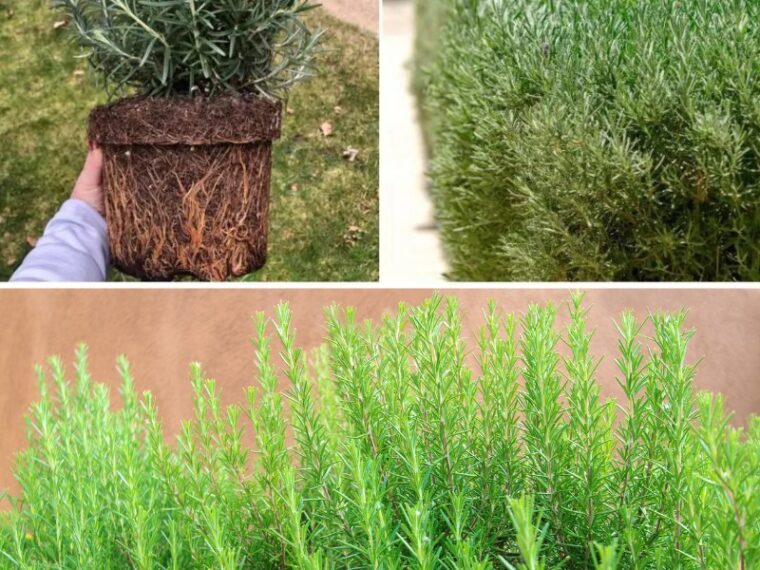1. Evergreen Beauty Year-Round
Rosemary is an evergreen shrub, which means it keeps its lush green foliage throughout the year. This makes it an excellent choice for creating hedges that maintain their appeal even in the winter months when other plants may lose their leaves.
2. Delightful Fragrance
One of the most charming aspects of a rosemary hedge is its aromatic foliage. As you brush past it, the herb releases its fresh, pine-like scent, adding an uplifting ambiance to your garden.
3. Edible and Versatile
Rosemary is a culinary powerhouse. Use it fresh or dried to flavor meats, potatoes, soups, and breads. Having a hedge ensures a steady supply of this kitchen staple.
4. Attracts Pollinators
The small, fragrant flowers of rosemary attract bees, butterflies, and other beneficial pollinators. A rosemary hedge can play a vital role in supporting your local ecosystem.
5. Deters Pests
Rosemary’s strong aroma acts as a natural pest repellent. It can help deter mosquitoes, flies, and other unwanted garden visitors while protecting nearby plants.
6. Low-Maintenance
Once established, rosemary is incredibly low-maintenance. It thrives in poor soils, requires minimal watering, and is resistant to most pests and diseases.
7. Drought-Tolerant
Rosemary’s Mediterranean origins make it a drought-tolerant plant, perfect for regions with limited water availability or for gardeners looking to conserve resources.
8. Natural Privacy Screen
A well-maintained rosemary hedge provides a dense, compact screen, making it ideal for creating privacy or defining the boundaries of your garden.
9. Longevity
Rosemary plants can live for decades when cared for properly. Planting a hedge is a long-term investment in your garden’s beauty and functionality.
10. Supports Landscaping Needs
Rosemary hedges are versatile in landscaping. Use them to line pathways, frame garden beds, or create geometric patterns in formal gardens.
How to Plant a Rosemary Hedge
1. Choosing the Right Variety
Opt for upright rosemary varieties such as Rosmarinus officinalis ‘Tuscan Blue’ or ‘Blue Spire’. These grow tall and dense, making them ideal for hedges.
2. Picking the Perfect Location
Rosemary thrives in full sun and well-draining soil. Choose a location that receives at least 6-8 hours of direct sunlight daily.
3. Preparing the Soil
- Drainage: Ensure the soil has good drainage; rosemary dislikes soggy roots.
- Amendments: If your soil is clay-heavy, mix in sand or gravel to improve texture.
- pH Levels: Rosemary prefers slightly alkaline to neutral soil (pH 6.0-7.5).
4. Spacing the Plants
- Space plants about 2-3 feet apart for a dense hedge.
- For faster coverage, plant them 1.5-2 feet apart, though this may require more frequent pruning.
5. Planting the Rosemary
- Dig a hole twice as wide and as deep as the plant’s root ball.
- Place the plant in the hole, ensuring the top of the root ball is level with the soil surface.
- Backfill with soil and gently press down to eliminate air pockets.
6. Watering
- Water thoroughly after planting.
- Once established, rosemary only needs occasional watering, especially during prolonged dry spells.
7. Mulching
- Apply a layer of mulch around the base to retain moisture and suppress weeds.
- Avoid piling mulch against the stem to prevent rot.
8. Pruning and Maintenance
- Prune your hedge regularly to maintain its shape and encourage bushy growth.
- Trim back after flowering to remove spent blooms and tidy up the hedge.
9. Fertilizing
Rosemary doesn’t require heavy feeding. Apply a balanced, slow-release fertilizer once a year in spring for optimal growth.
10. Dealing with Pests and Diseases
While rosemary is pest-resistant, occasional issues like aphids or powdery mildew may arise. Treat aphids with insecticidal soap and improve air circulation to prevent mildew.
Tips for Success
- Avoid Overwatering: Overwatering is the most common mistake when growing rosemary. Let the soil dry out between watering sessions.
- Frost Protection: In colder climates, protect your hedge with burlap or move potted plants indoors during winter.
- Companion Planting: Pair rosemary with plants like thyme and lavender for a harmonious Mediterranean-inspired garden.
Conclusion
Planting a rosemary hedge is a decision you’ll never regret. It’s a practical, beautiful, and fragrant addition to any garden, offering benefits for you and the environment. From its culinary uses to its ability to repel pests, rosemary proves to be an all-rounder. Follow these steps, and you’ll enjoy a thriving hedge that enhances your outdoor space for years to come.
FAQs
1. How long does it take for a rosemary hedge to grow?
A rosemary hedge can take 2-3 years to mature fully, depending on the variety and growing conditions.
2. Can I grow a rosemary hedge in containers?
Yes, rosemary can be grown in containers, but ensure the pots are large enough and have excellent drainage.
3. How tall can a rosemary hedge grow?
Upright rosemary varieties can grow up to 4-6 feet tall if left unpruned.
4. When is the best time to plant a rosemary hedge?
Spring and fall are the best times to plant rosemary, allowing the roots to establish in moderate temperatures.
5. Does rosemary attract bees?
Yes, rosemary flowers are highly attractive to bees and other pollinators, making it a great addition to a pollinator-friendly garden.




